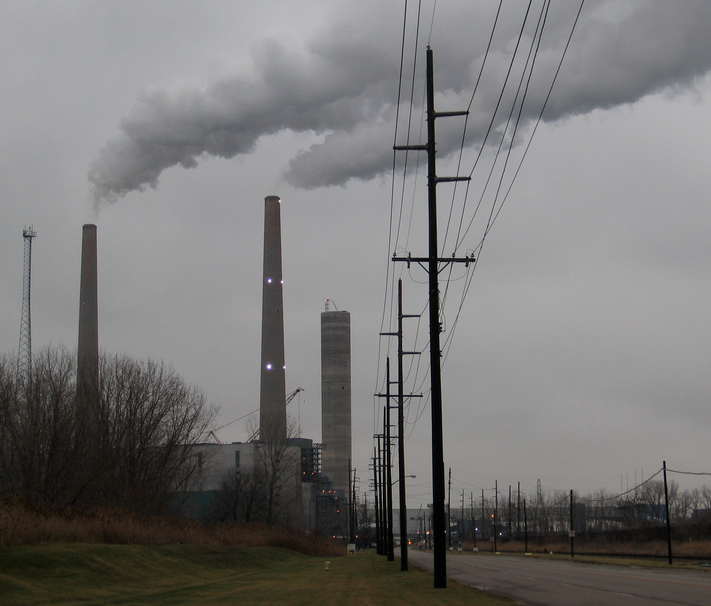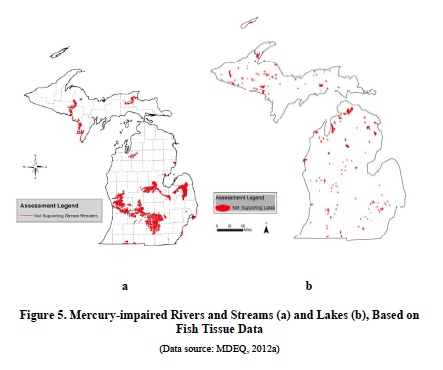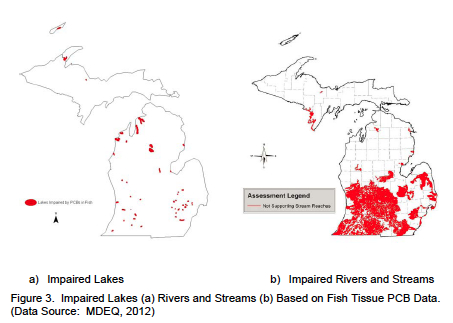Michigan’s toxic fish face long recovery, state finds
Water quality has improved in most Michigan lakes and rivers since Congress approved the federal Clean Water Act in 1972. But there remains a vexing, insidious pollution problem that could take 50 years to resolve.
Mercury and toxic PCBs emitted into the atmosphere from sources around the world rain down on Michigan’s lakes and rivers, contaminating fish and posing health threats to people who eat too much tainted fish.
It’s a problem Michigan cannot solve on its own.
The reason: 75 percent of the mercury and 55 percent of the PCBs that fall out of the sky and into the Michigan waters come from outside the state. Each year, about 6,000 pounds of mercury ride the wind into Michigan, according to U.S. Environmental Protection Agency estimates.
For the first time, the Michigan Department of Environmental Quality has drafted plans for reducing PCBs and mercury in fish and surface waters to safe levels. But preliminary documents obtained by Bridge paint a sobering picture of the daunting task at hand.
Reducing PCBs and mercury in Michigan fish to safe concentrations will require cutting global PCB emissions by 94 percent, and global mercury emissions 82 percent, according to the state’s draft cleanup plans, known as Total Maximum Daily Limits (TMDLs) for PCBs and mercury. Getting there will take about 50 years for PCBs, possibly longer for mercury, according to state officials.
“This is a global problem,” said Sylvia Heaton, a DEQ aquatic biologist specialist who coordinates state efforts to meet water quality standards. “We have to reduce sources of PCBs and mercury in Michigan, other states and internationally. It will take a long time to do that.”
PCBs, which were banned in the U.S. in 1979, are a group of chemicals that were used as coolants in transformers, and in carbonless copy paper. The chemicals are suspected carcinogens and are known to affect the nervous, immune and reproductive systems in humans. PCBs can be largely removed from fish by stripping away fatty tissue.
Most mercury in the environment is a byproduct of burning coal to make electricity and steel, and from treating wastewater. Mercury can cause neurological damage and other health problems in humans. Mercury pollution in fish can be particularly troublesome because the compound settles in the muscle tissue of fish, making it impossible to strip away the contaminant.
Michigan and several surrounding states have long had advisories urging people to limit their consumption of fish from mercury-polluted waters. Michigan has a statewide mercury fish consumption advisory.
That advisory may be here to stay for the foreseeable future.
Mercury keeps flowing
Power plants, factories and other sources of mercury continue to discharge the compound into the air and water – in Michigan, across the U.S. and around the world.
Michigan businesses and cities discharged 6,569 pounds of mercury into the air in 2005, according to the most recent government data. Coal-fired power plants accounted for 47 percent of those emissions, according to DEQ reports.
Environmentalists have repeatedly criticized utilities that operate the state’s coal-fired power plants, particularly DTE Energy, for spewing mercury into the air.
Randi Berris, a spokesperson for DTE Energy, said the utility has spent $2 billion in recent years installing better air pollution control equipment at its coal-fired power plants. She said the utility decreased mercury emissions 35 percent between 2007 and 2012.
“False and misleading claims about DTE’s emissions progress paint an inaccurate picture about the significant measures the company has taken to improve air quality,” Berris said. “Air quality in Michigan is better today than it has been in the last 40 years, due in large part to emissions reductions by DTE Energy and other Michigan utilities.
Berris said utilities alone cannot solve Michigan’s mercury problem. “Even if all of the coal-fired power plants in Michigan stopped operating tomorrow, it would make no impact on the TMDL; global mercury emissions will still exist as it is truly a worldwide issue,” she said.
State data show that most of the mercury discharged into the skies above Michigan drifts to neighboring states and Canada; some enters the mass of airborne mercury that circles the planet.
Not all mercury that’s emitted into the environment ends up in fish – only that portion that becomes methyl-mercury. But any mercury in water is a concern because it accumulates as it moves up the food chain.
The amount of mercury in a fish can be one million times higher than concentrations in the water, according to government data.
Joel Blum, a professor of earth and environmental sciences at the University of Michigan, said it’s impossible to predict how long it could take to reduce mercury to levels that would make all Michigan fish safe to eat.
“It’s fair to say it’s going to be a long time,” he said.
Michigan’s new mercury standard requires coal-fired power plants to cut mercury emissions by 90 percent by 2015. State officials have said loopholes in that requirement could reduce actual emissions by something closer to 75 percent.
New federal regulations require coal-fired power plants nationwide to reduce air emissions of mercury by 90 percent by 2016. The regulations are currently being challenged in federal court.
Blum said a number of mercury reduction initiatives are either in place or are being developed on a global scale. He said reducing mercury emissions in Michigan would improve air quality locally and globally.
“There are mercury hotspots around the state, downwind of mercury sources, that need to be addressed,” Blum said. “People in large cities are subjected to higher levels of mercury, so it’s a social justice issue.”
PCB levels going down
Although mercury and PCBs contaminate fish in most Michigan lakes and thousands of miles of rivers, there are glimmers of hope. Concentrations of PCBs have trended downward since 1990, according to state data.
PCB concentrations in the air and fish tissue decreased across Michigan from 1990-2007, according to the most recent available state data.
During that time, PCB concentrations in carp decreased in the River Raisin and the Muskegon, Grand, Kalamazoo and St. Joseph rivers. PCB also decreased in fish taken from Lake Gogebic, Houghton Lake and Higgins Lake, according to state data.
Mercury trends have been more complicated.
Mercury emissions in the U.S. dropped by 75 percent between 2000 and 2008, but there hasn’t been a corresponding reduction of mercury in Michigan fish. Average mercury concentrations in fish showed “minimal” decline from 1990-2007, according to the DEQ report.
State officials have made some progress over the past two decades in getting mercury out of the environment. From 1994-2007, state and private sector programs kept more than 32,000 pounds of mercury out of the environment, according to DEQ data.
The Legislature also has passed several laws in recent years banning mercury in medical devices, school equipment and consumer goods. A 2012 law banned open burning of any trash containing mercury (plastic, rubber, foam, chemically treated wood, textiles, electronics and hazardous waste).
“We have a very robust program to reduce mercury” in the air, water and consumer products, the DEQ’s Heaton said.
But the state also allows 139 facilities to discharge mercury into the environment. In 2012, these facilities collectively discharged 1,924 pounds of mercury into the air and 86 pounds into the water, according to government data.
James Clift, policy director for the Michigan Environmental Council, said mercury emissions will be a key issue this year as interest groups debate Gov. Rick Snyder’s plan to implement a “no regrets” energy plan by 2025.
The governor in December called for policies that make energy in Michigan more affordable, reliable and more environmentally friendly.
“From a Michigan perspective, we need to show that we’ve done everything we can to reduce mercury emissions,” Clift said.
See what new members are saying about why they donated to Bridge Michigan:
- “In order for this information to be accurate and unbiased it must be underwritten by its readers, not by special interests.” - Larry S.
- “Not many other media sources report on the topics Bridge does.” - Susan B.
- “Your journalism is outstanding and rare these days.” - Mark S.
If you want to ensure the future of nonpartisan, nonprofit Michigan journalism, please become a member today. You, too, will be asked why you donated and maybe we'll feature your quote next time!


 Coal-fired power plants account for nearly half of all mercury emissions in Michigan. (courtesy photo)
Coal-fired power plants account for nearly half of all mercury emissions in Michigan. (courtesy photo)
